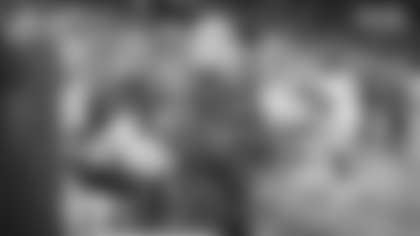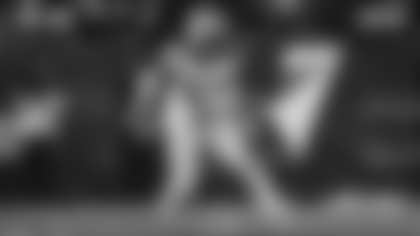Hello, Mr. Remmel. Your recollections and analysis are wonderful. There have been a lot of stories written about Johnny Blood McNally. I was wondering if you ever met him, what your impressions were, and how he ranked as a player. Thank you. - Dave (Des Moines, IA)
I did have the privilege, as a sportswriter/columnist for the Green Bay Press-Gazette (1944-74), of meeting and interviewing the fabled Johnny "Blood" McNally, who probably was the most daring and colorful player (on and off the field) in Packers history. For example, at one point during Johnny's playing career, Coach Curly Lambeau - concerned because McNally was inclined to break curfew and sneak out on the town, allegedly locked him in his hotel room the night before a game against the Bears in Chicago. Johnny, however, being a highly resourceful citizen, reportedly tied some bed sheets together, lowered himself out of his hotel window to the ground and proceeded to get out "among them."
Contrary to popular perception, I never saw him play. But, from all reports of his former teammates, such as fellow Hall of Famer Mike Michalske, he was a great athlete, a description which is supported by the fact that he was a charter selection to the Pro Football Hall of Fame when it opened in 1963. He reportedly was a gifted runner and receiver.
Johnny also, apparently, was highly intelligent. Some years after retiring from professional football, he became a member of the faculty at his alma mater, St. John's University in Collegeville, Minn., and also authored a book dealing with philosophy.
How close was Green Bay to losing its franchise on or around the 1958 season? - Joe (Auburn, WI)
I don't believe Green Bay was "close to losing its franchise" in or around the 1958 season, since the Packers organization was relatively solvent at that point. A few years earlier, however (in 1949), the team played an intra-squad "game" at old City Stadium (on Green Bay's East Side) to raise sufficient funds to finish the season (approximately 25,000 tickets, at $2 per person, reportedly were sold.)
The organization then conducted a stock drive the following spring (1950), a project which raised $118,000. Shortly thereafter, network television began to become an increasingly substantial source of revenue, and the Packers - along with the rest of the National Football League, became progressively more solvent over time.
When will Tom Brown and Marv Fleming be put in the Packers Hall of Fame to complete the starting Super Bowl I roster? They are the only starters not in the Hall. - Bill (Green Bay, WI)
Both Brown and Fleming are on the list of HOF nominees and eligible for induction. And both were starters and solid players during their Green Bay careers. However, my guess is that their chances of being selected would not be overly bright because, in each case, their "measurables" - their career statistics and accomplishments - did not rank among the organization's all-time leaders.
Mr. Remmel, Greetings from Kirkuk Air Base, Iraq. Long time ago, the Packers had a player by the name of Jug Earp. Was he any relation to the Earps of Western lore? - John (Kirkuk, Iraq)
At one time, it was rumored that the Packers' Francis L. "Jug" Earp was a cousin of the legendary Wyatt Earp. But, to the best of my knowledge, that rumor has not been documented.
Jug Earp, a center out of Monmouth College, had a 10-year playing career with the Packers (1922-32), helping the team win its first three NFL championships (1929-30-31). He later rejoined the team in 1950 to serve as the club's publicity director, continuing in that role through the 1954 season.
I believe 1965 was the finest year in NFL history, as your recent column suggests. The Bears rookies Sayers & Butkus had that team within an inch of the playoffs...the Colts, Browns, Packers and Cowboys all had Hall of Famers on their rosters. The Pack had two rookies, Grabowski and Anderson on their squad. Whatever happened to those two? - Doug DeMars (Miami, FL)
Both Donny Anderson and Jim Grabowski were first-round draft choices, Anderson out of Texas Tech as a "future" in 1965 and Grabowksi out of the University of Illinois in 1966, with the expectation that they would be the successors to Paul Hornung and Jim Taylor - then nearing the end of their respective playing careers - as the Packers' new backfield tandem.
Anderson, the seventh player chosen in the '65 draft and a versatile performer who was the team's (left-footed) punter as well as a gifted receiver and talented running back, went on to substantial success in Green and Gold before being traded to the then St. Louis Cardinals for running back MacArthur Lane prior to the 1972 season. Anderson currently ranks eighth in Packers annals for combined rushing and receiving yards with 4,890 yards (3,165 rushing and 1,725 receiving). He also is tied with the late Tony Canadeo for 29th place in Packers career scoring with 186 points.
Grabowksi, the ninth player selected overall in the 1966 draft, was impressive at the outset of his pro career, particularly with a 111-yard rushing performance against the Chicago Bears in the second game of the 1967 season, his second in the NFL. But, six weeks later, he suffered a serious knee injury in a game against the then Baltimore Colts and played in only one more game over the balance of that season. He underwent surgery on the damage knee and was not the same player when he returned for the 1968 season. He, however, remained on the Green Bay roster - performing in a limited role - through the 1970 season. Released, he signed on with the Bears in 1971 and retired at the end of that season.
Anderson today is a successful businessman in Dallas and Grabowski still lives in his native Illinois (Chicago area) and, as of last hearing, was continuing to serve as an analyst on radio broadcasts of his alma mater's football games.
Lee, as a fan from England, I was wondering if the Packers have ever played an exhibition game anywhere overseas? - Bruce (Sittingbourne, England)
Yes, the Packers played an American Bowl game against the Kansas City Chiefs in Tokyo, Japan, August 2, 1998, Green Bay posting a 27-24 victory in overtime. One year earlier, the Packers played on foreign soil for - as far as can be determined - the first time, defeating the Buffalo Bills, 35-3, in a preseason game at the Toronto, Ontario, Canada SkyDome, August 16, 1997.
Continuing an association with the team that is more than 55 years old, Lee Remmel was named the first official Team Historian of the Green Bay Packers in February 2004. The former *Green Bay Press-Gazette reporter and Packers public relations director, Remmel will write regular columns for Packers.com as part of his new assignment.
In addition to those articles, Remmel will answer fan questions in a monthly Q&A column. To submit a question to Remmel, click here. *














